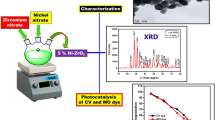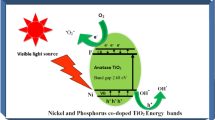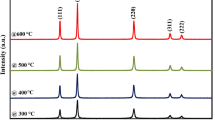Abstract
Photocatalytic removal of Cr6+ from aqueous solution using dye-sensitized nanoscale ZnO under visible light irradiation was studied in this work. First, nanoscale ZnO was prepared by the co-precipitation method. Then, sensitization of nanoscale ZnO by Alizarin Red S dye followed. Further, nanoscale ZnO and dye-sensitized nanoscale ZnO (designated nanoZnO and nanoZnO*, respectively) were both characterized by various photospectrometry methods, such as scanning electron microscopy (SEM), scanning electron microscopy-energy dispersive X-ray spectrometry (SEM-EDS), EDS-mapping, transmission electron microscopy (TEM), and X-ray diffractometry (XRD). It was found that both types of prepared particles are spherical in shape with a size range of 20 to 50 nm. XRD patterns showed that both nanoZnO and nanoZnO* had the same crystalline structure of zincite. In the photocatalytic reduction aspect, effects of different light sources and dosage of nanoZnO* on Cr6+ reduction ([Cr6+]initial = 20 mg/L) were evaluated in this work. Treatment of chromium(VI)-bearing wastewater under the conditions of using 1.0 g/L of nanoZnO*, neutral pH, irradiation of household fluorescence lamps for 6 h and 17 h would yield Cr6+ removal efficiencies of about 68% and 90%, respectively. When the household fluorescence lamps were replaced by visible-light lamps of 400–500 nm in wavelength, the corresponding removal efficiencies dropped to about 50% and 75%, respectively. When nanoZnO* was irradiated by sunlight under almost the same experimental conditions, the Cr6+ reduction efficiency increased up to 90%. In summary, sensitizing nanoscale ZnO with Alizarin Red S dye for photocatalytic applications using visible light is feasible. The relevant reaction mechanism and pathways were also proposed in this work.













Similar content being viewed by others
References
Akyol A, Yatmaz HC, Bayramoglu M et al (2004) Photocatalytic decolorization of Remazol Red RR in aqueous ZnO suspensions. Appl Catal B: Environ 154:19–24
Bae E, Choi W (2003) Highly enhanced photoreductive degradation of perchlorinated compounds on dye-sensitized metal/TiO2 visible light. Environ Sci Technol 37:147–152
Behnajady MA, Modirshahla N, Hamzavi R et al (2006) Kinetic study on photocatalytic degradation of C.I. Acid Yellow 23 by ZnO photocatalyst. J Hazard Mater B 133:226–232
Chakrabarti S, Dutta BK (2004) Photocatalytic degradation of model textile dyes in wastewater using ZnO as semiconductor catalyst. J Hazard Mater B 112:269–278
Chatterjee D, Dasgupta S, Rao NN et al (2006) Visible light assisted photodegradation of halocarbons on the dye modified TiO2 surface using visible light. Sol Energy Mater Sol Cells 90:1013–1020
Chen CC (2006) Degradation pathways of ethyl violet by photocatalytic reaction with ZnO dispersions. J Mol Catal A: Chem 264:82–92
Chen PL, Ma XY, Yang DR et al (2006) Fairly pure ultraviolet electroluminescence from ZnO-based light-emitting devices. Appl Phys Lett 89:111112–111114
Cho Y, Choi W, Lee C-H, Hyeon T, Lee H-I et al (2001) Visible light-induced degradation of carbon tetrachloride on dye-sensitized TiO2. Environ Sci Technol 35:966–970
Cho Y, Kyung H, Choi W et al (2004) Visible light activity of TiO2 for the photoreduction of CCl4 and Cr(VI) in the presence of nonionic surfactant (Brij). Appl Catal B 52:23–32
Daneshvar N, Salari D, Khataee AR et al (2004) Photocatalytic degradation of Azo Dye Red 14 in water on ZnO as an alternative catalyst to TiO2. J Photochem Photobiol A 162:317–322
Hara K, Horiguchi T, Kinoshita T, Sayama K, Sugihara H, Arakawa H et al (2000) Highly efficient photon-to-electron conversion with mercurochrome-sensitized nanoporous oxide semiconductor solar cells. Sol Energy Mater Sol Cells 64:115–134
Khalil LB, Mourad WE, Rophael MW et al (1998) Photocatalytic reduction of environmental pollutant Cr(VI) over some semiconductor under UV/visible light illumination. Appl Catal B: Environ 17:267–273
Kim KK, Koguchi N, Ok YW, Seong TY, Park SJ et al (2004) Fabrication of ZnO quantum dots embedded in an amorphous oxide layer. Appl Phys Lett 84:3810–3812
King DS, Nix RM (1996) Thermal stability and reducibility of ZnO and Cu/ZnO catalysts. J Catal 160:76–83
Kwon YJ, Kim KH, Lim CS, Shim KB et al (2002) Characterization of ZnO nanopwders synthesized by the polymerized complex method via an organochemical route. J Ceram Proc Res 3:146–149
Li D, Hajime H (2004) Enhancement of photocatalytic activity of sprayed nitrogen-containing ZnO powders by coupling with metal oxides during the acetaldehyde decomposition. Chemosphere 54:1099–1110
Li D, Haneda H (2003) Morphologies of zinc oxide particles and their effects on photocatalysis. Chemosphere 51:129–137
Lin H-F, Liao S-C, Hung S-W, Hung S-W (2005) The dc thermal plasma synthesis of ZnO nanoparticles for visible-light photocatalyst. J Photochem Photobiol A 174:82–87
Mohapatra P, Samantaray SK, Parida K et al (2005) Photocatalytic reduction of hexavalent chromium in aqueous solution over sulphate modified titania. J Photochem Photobiol A 170:189–194
Neppolian B, Sakthivel S, Arabindoo B, Palanichamy M, Murugesan V et al (1999) Degradation of textile dye by solar light using TiO2 and ZnO photocatalysts. J Environ Sci Heal A 34:1829–1838
Parida KM, Parija S (2006) Photocatalytic degradation of phenol under solar radiation using microwave irradiation zine oxide. Sol Energy 80:1048–1054
Rabindranathan S, Devipriya S, Yesodharan S et al (2003) Photocatalytic degradation of phosphamidon on semiconductor oxides. J Hazard Mater B 102:217–229
Selvam K, Muruganandham M, Muthuvel I, Swaminathan M et al (2007) The influence of inorganic oxidants and metal ions on semiconductor sensitized photodegradation of 4-Fluorophenol. J Chem Eng 128:51–57
Sharma GD, Sharma SK, Roy MS et al (2003) Charge transfer and photogeneration process in device consisting of safranine O dye and TiO2-nanoparticles. Mater Sci Eng B 100:13–17
Steiner SA, Porter MD, James JS et al (2006) Ultrafast concentration and speciation of Chromium(III) and (VI). J Chromatogr A 1118:62–67
Wang J, Gao L (2004) Hydrothermal synthesis and photoluminescence properties of ZnO nanowires. Solid State Commun 132:269–271
Wang L, Wu J, Li T, Cheng Y, Huang M et al (2005) Synthesis and photocatalytic properties of HTaWO6 intercalated with oxide materials. J Porous Mater 12:23–27
Wang JX, Sun XW, Wei A, Lei Y, Cai XP, Li CM, Dong ZL et al (2006) Zinc oxide nanocomb biosensor for glucose detection. Appl Phys Lett 88:233106–233108
Wu L, Wu Y, Shi Y, Wei H et al (2006) Synthesis of ZnO nanorods and their optical absorption in visible-light region. Rare Metals 25:68–73
Yang GCC, Li CJ (2004) Photocatalytic reduction of Cr6+–containing wastewater using nanoscale ZnO. Proc. 1st Symp. on Environ. Prot. & Nanotechnol., September 16, Hsinchu, Taiwan. (in Chinese)
Yuan F, Hu P, Yin C, Huang S, Li J et al (2003) Preparation and properties of zinc oxide nanoparticles coated with zinc aluminate. J Mater Chem 13:634–637
Acknowledgment
The authors would like to thank the Center for NanoScience & NanoTechnology, National Sun Yat-Sen University, Taiwan for its partial support of this study.
Author information
Authors and Affiliations
Corresponding author
Rights and permissions
About this article
Cite this article
Yang, G.C.C., Chan, SW. Photocatalytic reduction of chromium(VI) in aqueous solution using dye-sensitized nanoscale ZnO under visible light irradiation. J Nanopart Res 11, 221–230 (2009). https://doi.org/10.1007/s11051-008-9423-y
Received:
Accepted:
Published:
Issue Date:
DOI: https://doi.org/10.1007/s11051-008-9423-y




